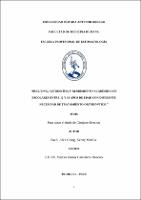Bullyng, autoestima y rendimiento académico en escolares entre 12 y 18 años de edad con diferente necesidad de tratamiento ortodóntico

View/Open
Download
(application/pdf: 852.3Kb)
(application/pdf: 852.3Kb)
Date
2016Author(s)
Julca Ching, Kenny Mirela
Metadata
Show full item recordAbstract
Objetivo: El presente estudio tuvo como objetivo comparar al bullying,
autoestima y el rendimiento académico en escolares entre los 12 y 18 años de
edad con diferente necesidad de tratamiento ortodóntico.
Material y métodos: El estudio prospectivo, transversal, comparativo, incluyó un
total de 147 alumnos de secundaria. Para determinar el bullying y autoestima en
los estudiantes se aplicaron cuestionarios validados, se procedió también a la
valoración de los promedios finales de cada curso en los escolares para medir su
rendimiento académico y para determinar la diferente necesidad de tratamiento
ortodóntico se utilizó el Índice de Estética Dental
(DAI). Para la comparación del
bullying, autoestima y el rendimiento académico según la necesidad de
tratamiento ortodóntico, se empleó el Análisis de Varianza y la prueba Kruskal
Wallis según el cumplimiento e incumplimiento de los supuestos básicos de
normalidad y homogeneidad de varianzas. Se consideró un nivel de significancia
del 5%.
Resultados: Los resultados mostraron puntuaciones de autoestima de 21.6, 20.9,
21.0 y 20.5 para los grupos que no presentaron necesidad de tratamiento,
maloclusión definida, maloclusión severa y maloclusión grave respectivamente;
así mismo, para bullying fueron de 14.2, 15.4, 14.5 y 13.0; mientras que, para
rendimiento académico fueron de 13.6, 12.5, 12.9, 13.2. No se encontraron
diferencias estadísticamente significativas entre los diversos grupos evaluados.
Conclusiones: No existen diferencias entre bullying, autoestima y rendimiento
académico en escolares de 12 a 18 años de edad con diferente necesidad de
tratamiento ortodóntico Objective: This study aimed to compare the bullying, self-esteem and academic
performance among students whose ages were about 12 and 18 years old with
different orthodontic treatment need.
Material and methods: The prospective, transversal, comparative, longitudinal
study includes a total of 380 high school students, which according to the
exclusion criteria, only 147 were considered.
Results: With regard to the questionnaires; the first was applied to determine the
presence or absence of bullying in high school students, and for the evaluation of
self-esteem, was made by Rosenberg Test. Likewise the final scores of each high
students´ courses were taken into account. And finally to determine the different
need of orthodontic treatment malocclusion, Dental Aesthetics Index (DAI) was
used. For comparison of bullying, self-esteem and academic performance
according to need orthodontic treatment, analysis of variance and Kruskal Wallis
as compliance and breach of the basic assumptions (normality and homogeneity
of variances), respectively employed. A level of significance of 5% was
considered.
Conclusion: The results showed self-esteem scores of 21.6, 20.9, 21.0 and 20.5
for groups showed no need for treatment, defined malocclusion, severe
malocclusion and severe malocclusion respectively; likewise, for bullying they
were 14.2, 15.4, 14.5 and 13.0; whereas for academic achievement were 13.6,
12.5, 12.9, 13.2. No statistically significant differences were found between the
various groups evaluated.
Results: Were not statistically significant differences bullying, self-esteem and
academic performance between levels of need for orthodontic treatment.
Keywords: Bullying, self-esteem, academic performance, students, need of
orthodontic treatment, DAI, malocclusion.
Subject
Collections
- Estomatología [687]

